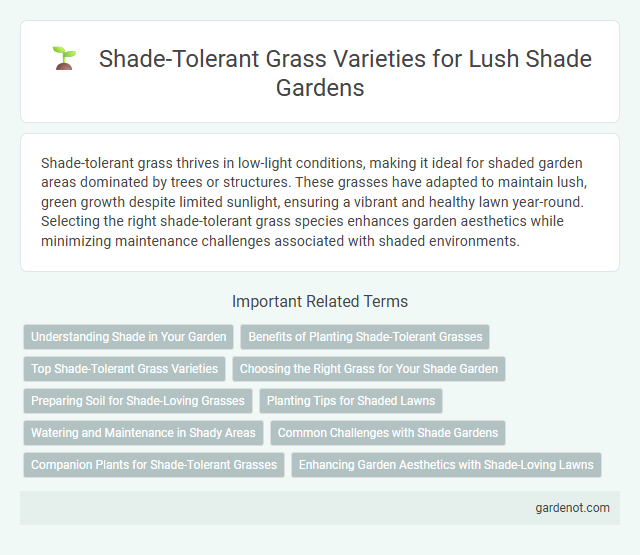Shade-tolerant grass thrives in low-light conditions, making it ideal for shaded garden areas dominated by trees or structures. These grasses have adapted to maintain lush, green growth despite limited sunlight, ensuring a vibrant and healthy lawn year-round. Selecting the right shade-tolerant grass species enhances garden aesthetics while minimizing maintenance challenges associated with shaded environments.
Understanding Shade in Your Garden
Shade-tolerant grass varieties such as Fine Fescue and St. Augustine thrive in low-light conditions by adapting to limited photosynthesis. Understanding the degree of shade--whether dense, filtered, or partial--is crucial for selecting the appropriate grass species that can endure reduced sunlight. Soil moisture and airflow also influence the health and growth of shade-tolerant turf in shaded garden areas.
Benefits of Planting Shade-Tolerant Grasses
Shade-tolerant grasses improve soil stability and prevent erosion in low-light garden areas by establishing dense root systems. These grasses enhance garden aesthetics by maintaining a lush, green appearance even under tree canopies or shaded spaces. Their resilience reduces the need for frequent watering and fertilizing, promoting sustainable, low-maintenance landscape care.
Top Shade-Tolerant Grass Varieties
Top shade-tolerant grass varieties such as Fine Fescue, St. Augustine Grass, and Zoysia Grass thrive in low-light garden areas, maintaining lush green coverage despite limited sunlight. Fine Fescue is highly adaptable to dense shade and low maintenance, making it ideal for shaded residential landscapes. St. Augustine Grass performs well in warm climates with moderate shade, while Zoysia Grass offers excellent durability and shade resistance, supporting healthy growth under tree canopies.
Choosing the Right Grass for Your Shade Garden
Selecting shade-tolerant grass such as fine fescue, centipede grass, or St. Augustine grass ensures optimal growth in low-light conditions common in shade gardens. Consider soil type, moisture levels, and the degree of shade when choosing grass to enhance resilience and appearance. Proper grass selection promotes a lush, green lawn that thrives beneath trees and shaded areas, reducing maintenance and improving garden aesthetics.
Preparing Soil for Shade-Loving Grasses
Preparing soil for shade-loving grasses involves improving drainage and increasing organic matter to enhance root development and nutrient availability. Incorporating compost or well-rotted leaf mulch boosts soil fertility and moisture retention, crucial for shade-tolerant grass species like fine fescues and St. Augustine grass. Testing soil pH and adjusting it to a slightly acidic to neutral range (6.0-7.0) optimizes conditions for healthy grass growth in shaded garden areas.
Planting Tips for Shaded Lawns
Select fine fescues and St. Augustine grass varieties for optimal shade tolerance in shaded lawns. Prepare the soil by testing pH levels, ensuring they range from 6.0 to 7.0, and incorporate organic matter to improve drainage and nutrient retention. Plant grass during early spring or fall, apply a thin layer of mulch around seedlings to retain moisture, and avoid heavy foot traffic to promote healthy growth in low-light conditions.
Watering and Maintenance in Shady Areas
Shade-tolerant grass varieties require moderate watering to prevent fungal diseases common in low-light, moist environments. Maintaining proper soil drainage and avoiding overwatering helps root health and reduces lawn disease risks in shaded gardens. Regular raking and removing debris improve air circulation, promoting dense, healthy turf growth under canopy cover.
Common Challenges with Shade Gardens
Shade-tolerant grass often struggles with insufficient sunlight, leading to thin, patchy growth and increased vulnerability to diseases such as fungal infections. Soil moisture imbalance is a common challenge, as shaded areas retain moisture longer, promoting root rot while also creating an environment prone to moss and weed invasion. Proper selection of shade-tolerant species like fine fescues and maintenance practices including aeration and balanced fertilization are essential to overcoming these obstacles in shade gardens.
Companion Plants for Shade-Tolerant Grasses
Companion plants for shade-tolerant grasses like fescues and fine leaf bluegrass include hostas, ferns, and astilbes, which thrive in low-light conditions and enhance the garden's texture and color contrast. These plants improve soil moisture retention and reduce weed growth, promoting healthier grass development by creating a balanced microenvironment. Incorporating shade-loving groundcovers such as ajuga and pachysandra alongside shade-tolerant grasses helps maintain dense foliage and prevents erosion in shaded garden areas.
Enhancing Garden Aesthetics with Shade-Loving Lawns
Shade-tolerant grasses such as fine fescues and St. Augustine grass thrive in low-light garden areas, creating lush, green lawns that enhance overall garden aesthetics. These grasses maintain vibrant color and texture even under dense tree canopies, providing year-round visual appeal and a soft, inviting ground cover. Selecting shade-adapted grass varieties optimizes lawn health while complementing shade garden landscapes with increased durability and minimal maintenance.
Shade-tolerant grass Infographic

 gardenot.com
gardenot.com